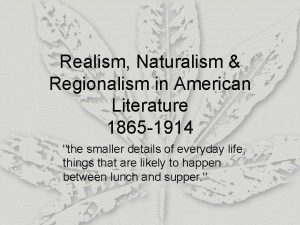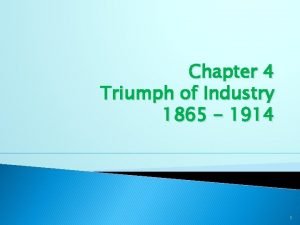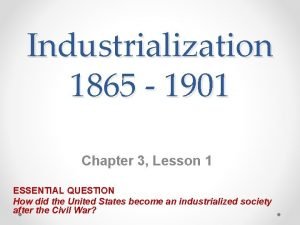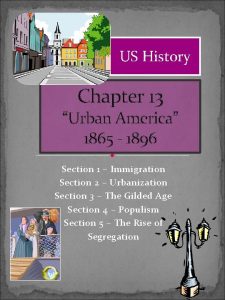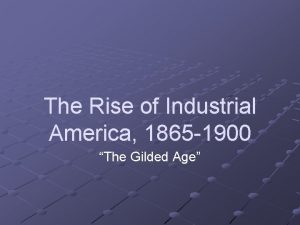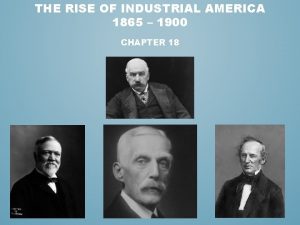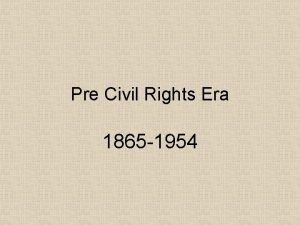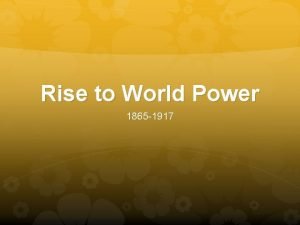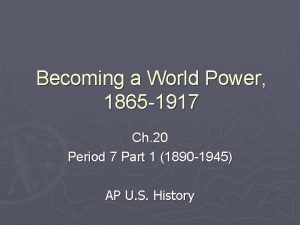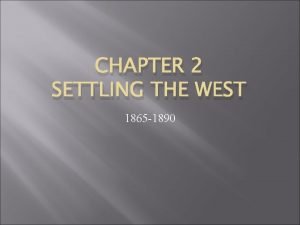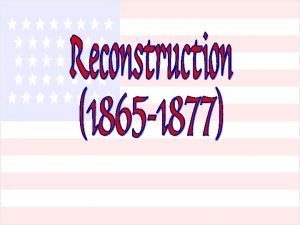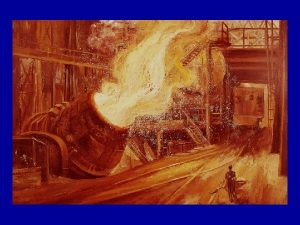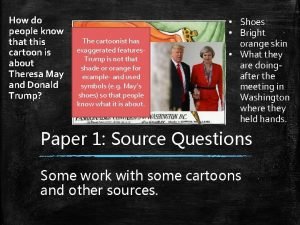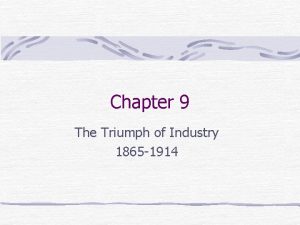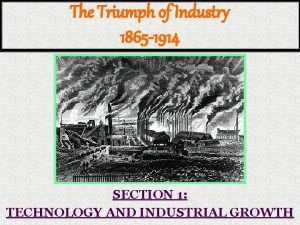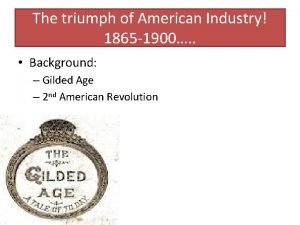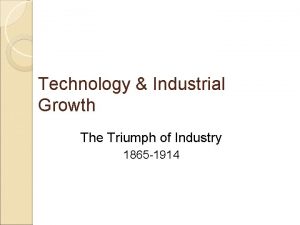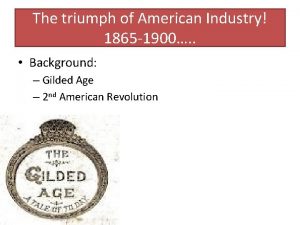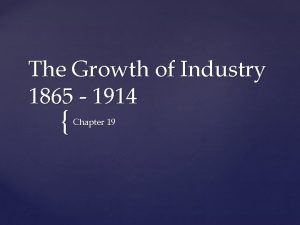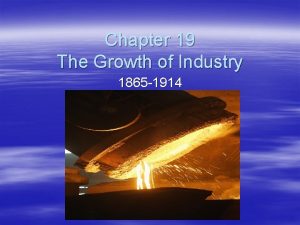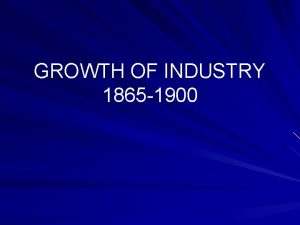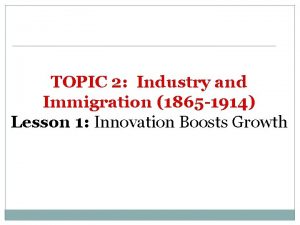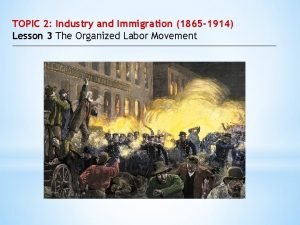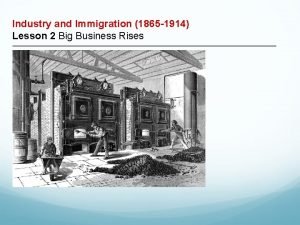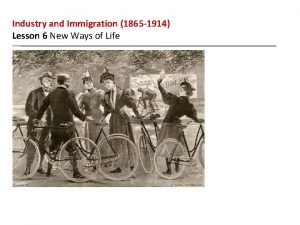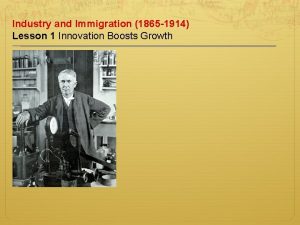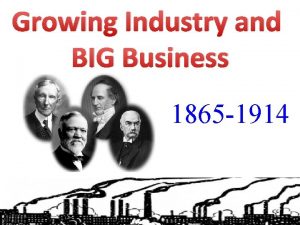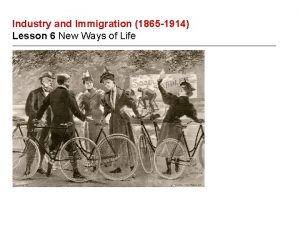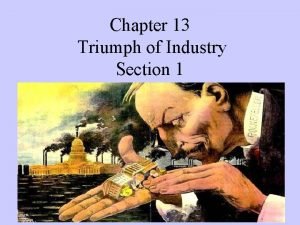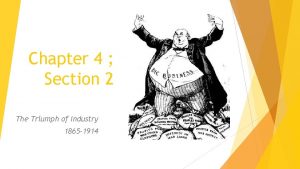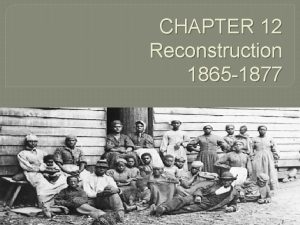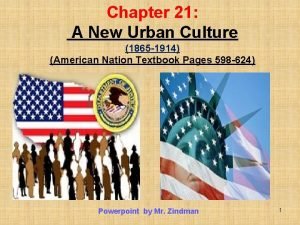Chapter 4 The Triumph of Industry 1865 1914
























- Slides: 24

Chapter 4 The Triumph of Industry 1865 -1914

Technology & Industrial Growth Objectives Analyze the factors that led to the industrialization of the US in the late 1800’s. Explain how new inventions and innovations changed Americans’ lives. Describe the impact of industrialization in the late 1800’s. Key Terms & People Entrepreneur Protective tariff Laissez faire Patent Thomas Edison Bessemer process Suspension bridge Time zone Mass production

Encouraging Industrial Growth What sparked industrialization = The Civil War More products needed – guns, ammo, medical supplies, uniforms Food Industry – shipping food long distances Railroads More expanded efficient power methods

Natural Resources Fuel Growth Coal Mines Located along the Eastern Seaboard Provided fuel to power steam locomotives and factories Forests Cut into lumber for construction In 1859, Edwin Drake drilled the world’s first oil well in Titusville, PA. Before: obtained from boiling down whale blubber After: Drilling was cheaper and saved the whales! v The oil industry quickly grew and brought about the kerosene and gasoline industries.







The Workforce grows Ø US Population Statistics 600, 000 2 = 1830’s million = 1850’s +10 22 Why? million = 1860 – 1890 million = 1890 – 1924

Capitalism encourages entrepreneurs 1868 – Ragged Dick, or Street Life in New York by Horatio Alger was published. The main idea of the novel is that anyone could vault from poverty and obscurity to wealth and fame. “Rags to Riches” The “rags to riches” idea depended on the system of capitalism, or free enterprise – individuals own most businesses. The heroes of capitalism are entrepreneurs – people who invest money in a product or enterprise in order to make a profit. ENTREPRENEURS FUELED INDUSTRIALIZATION


Government Policies Encourage Free Enterprise Railroads Government provided millions of acres in return for their promise to quickly link the East and West coasts. Protective Tariffs – taxes that would make imported goods cost more than those locally made. Encouraged laissez-faire – allowed businesses to operate under minimal government regulations. Strong legal system Enforced private property rights




Electricity Transforms Life Thomas Edison 1876 - Established a research laboratory supported by wealthy industrialists, such as J. P. Morgan. Received more than 1, 000 patents for new inventions. 1880 – The Light Bulb was invented. George Westinghouse Developed technology to send electricity over long distances.

Revolutionizing Communications Samuel More 1844 – perfected telegraph technology Alexander Graham Bell 1876 – patented the telephone. At first, 148 telephone companies strung more than 34, 000 miles of wire. 1900 = more than one million telephones Gugleilmo Marconi 1896 – invented the wireless telegraph Helped radio lead to the invention of the

Steel: A Practical Wonder Henry Bessemer 1850’s – England Discovered how to purify iron = STEEL His method became known as the Bessemer Process. 1890 – US was outproducing British steel manufactures. Benefits of Steel: Skyscrapers Elevators Suspension Bridge 1 st Suspension Bridge = Brooklyn Bridge Completed Longest in 1883. bridge in the world at the time of construction!


Technology & Transportation Railroads 1883 – 3 transcontinental railroad lines were available in the US. Problems? Result = Time Zones – created in 1884 by 27 countries. Other Technologies: Streetcars Commuter trains Subways Automobiles – 1902 Airplaines - 1903

Changing American Society Farms Became mechanized Fewer farm laborers More people moved to urban areas “Industrial North” Pros: easy access to clothing & supplies that they had previously made by hand Cons: Higher cost of living, dependent upon cash wages to buy food, performed repetitive work in factories.

What about the Environment? Late 1800’s = New environmental issues emerged. Industrial waste had risen dramatically. Mining was destroying the land Agricultural production had led to soil erosion & dust storms Congress responded by setting aside protected lands that would become part of the National Park Service. 1872 = Yellowstone National Park – First National Park
 Realism naturalism and regionalism
Realism naturalism and regionalism Chapter 4 the triumph of industry
Chapter 4 the triumph of industry Industrialization 1865 to 1901
Industrialization 1865 to 1901 Chapter 17 section 2 communists take power in china
Chapter 17 section 2 communists take power in china Urban america 1865 to 1896
Urban america 1865 to 1896 St helen’s smelting co v tipping (1865)
St helen’s smelting co v tipping (1865) The rise of industrial america 1865-1900
The rise of industrial america 1865-1900 The rise of industrial america 1865-1900
The rise of industrial america 1865-1900 1954-1865
1954-1865 Becoming a world power 1865-1917
Becoming a world power 1865-1917 Monet
Monet Chapter 20 becoming a world power notes
Chapter 20 becoming a world power notes Settling the west 1865-1890
Settling the west 1865-1890 Al cruzar una planta de guisantes de flores purpura
Al cruzar una planta de guisantes de flores purpura Where did the term impressionism come from
Where did the term impressionism come from Whats the compromise of 1877
Whats the compromise of 1877 Industrialization (1865 to 1901 worksheet answers key)
Industrialization (1865 to 1901 worksheet answers key) 1865 to 1900 inventions
1865 to 1900 inventions Triumph pharmaceuticals
Triumph pharmaceuticals Balkandum and balkandee
Balkandum and balkandee The triumph of time swinburne
The triumph of time swinburne Triumph of bacchus
Triumph of bacchus The romantic triumph
The romantic triumph Beowulf hero archetype
Beowulf hero archetype Triumph group
Triumph group
